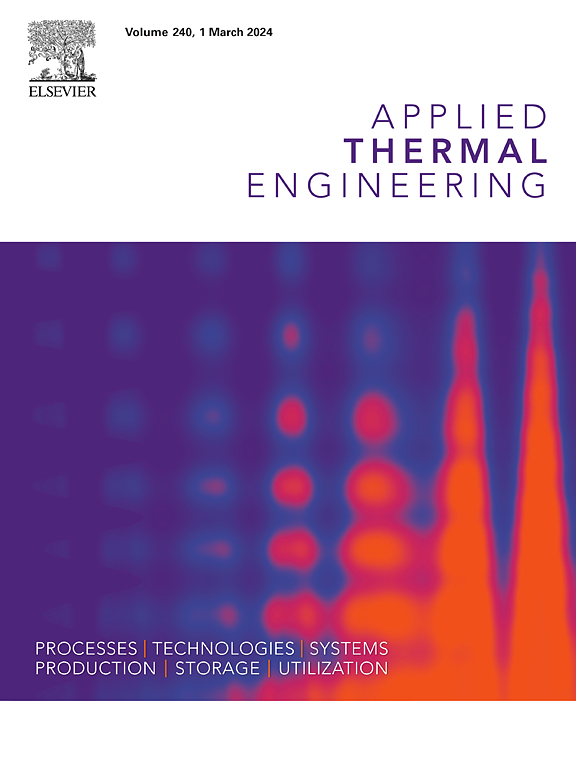带线圈插片的矩形管道强化传热:在建筑集成CPVT系统中的应用
IF 6.9
2区 工程技术
Q2 ENERGY & FUELS
引用次数: 0
摘要
本研究在非均匀热流条件下,模拟建筑一体化聚光光伏热(CPVT)系统的实际运行环境,评估了装有线圈插片的矩形管道的热工和水力性能。其目的是通过改善光伏电池的散热来减轻局部过热。实验是在一个长2.5 m,截面为23 × 8 mm2的管道上进行的,暴露在集中太阳通量为16,667和25,000 W/m2的情况下。以水作为工作流体,对螺距(7.5-19.3 mm)、厚度(0.6-1.4 mm)和直径(7-7.5 mm)不同的三种线圈结构进行了测试。性能指标包括PV表面温度降低、努塞尔数和范宁摩擦系数,在较宽的雷诺数范围内(700-20,000)进行评估。结果表明,换热性能提高了77%,相应的壁温降低了6℃。在整个雷诺数范围内,插入物促进了早期湍流,有效地抑制了平滑导管中观察到的层流到湍流的过渡状态。这导致了更稳定的湍流条件。在测试的配置中,确定了最佳的插入几何形状,在增强传热和压降损失之间提供了最佳折衷。总的来说,研究结果证实了被动技术在改善CPVT系统热调节方面的有效性,并通过将非圆形管道几何形状与非均匀加热结合起来解决了一个显著的研究空白,这是现有文献中很少探索的操作条件。本文章由计算机程序翻译,如有差异,请以英文原文为准。
Heat transfer enhancement in rectangular ducts with wire coil inserts: Applications in building-integrated CPVT systems
This study evaluates the thermal and hydraulic performance of rectangular ducts equipped with wire coil inserts under non-uniform heat flux conditions, replicating realistic operating environments in building-integrated Concentrated Photovoltaic Thermal (CPVT) systems. The aim is to mitigate localized overheating by improving heat removal from the photovoltaic cells. Experiments were carried out on a 2.5 m long duct with a 23 × 8 mm2 cross-section, exposed to concentrated solar fluxes of 16,667 and 25,000 W/m2. Water was used as the working fluid, and three wire coil configurations, varying in pitch (7.5–19.3 mm), thickness (0.6–1.4 mm), and diameter (7–7.5 mm), were tested. Performance metrics including PV surface temperature reduction, Nusselt number, and Fanning friction factor were assessed over a wide Reynolds number range (700–20,000). Results show that heat transfer was enhanced by up to 77 %, with a corresponding wall temperature reduction of up to 6 °C. Throughout the entire Reynolds number range, the inserts promoted early turbulence, effectively suppressing the laminar-to-turbulent transition regime observed in the smooth duct. This led to more stable turbulent flow conditions. Among the tested configurations, an optimal insert geometry was identified, offering the best compromise between enhanced heat transfer and pressure drop penalty. Overall, the findings confirm the effectiveness of passive techniques for improving thermal regulation in CPVT systems and address a notable research gap by combining non-circular duct geometry with non-uniform heating, an operating condition rarely explored in existing literature.
求助全文
通过发布文献求助,成功后即可免费获取论文全文。
去求助
来源期刊

Applied Thermal Engineering
工程技术-工程:机械
CiteScore
11.30
自引率
15.60%
发文量
1474
审稿时长
57 days
期刊介绍:
Applied Thermal Engineering disseminates novel research related to the design, development and demonstration of components, devices, equipment, technologies and systems involving thermal processes for the production, storage, utilization and conservation of energy, with a focus on engineering application.
The journal publishes high-quality and high-impact Original Research Articles, Review Articles, Short Communications and Letters to the Editor on cutting-edge innovations in research, and recent advances or issues of interest to the thermal engineering community.
 求助内容:
求助内容: 应助结果提醒方式:
应助结果提醒方式:


